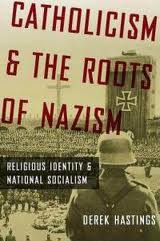ACCH Quarterly Vol. 15, No. 2, June 2010
Review of Derek Hastings, Catholicism and the Roots of Nazism: Religious Identity and the Early Nazi Movement in Munich (Oxford: Oxford University Press, 2009), 312 pp. ISBN: 0195390245.
By Beth Ann Griech-Polelle, Bowling Green State University
For many people the National Socialist movement is forever embedded in their minds with neo-pagan revivals and pseudo-sacral rituals. Derek Hastings’ work, Catholicism and the Roots of Nazism, attempts to prove otherwise.Hastings’ research reveals a distinctly Catholic overtone in the early development of the Nazi movement in Munich and its environs and he argues that, up until the failed 1923 Beerhall Putsch, the movement was overwhelmingly Catholic in its orientation.Hastings’ greatest contribution here is to provide well-researched evidence that addresses the very early moments of the NSDAP’s formation, something that has hitherto been largely neglected by historians of the Third Reich. He also makes a major contribution by providing portraits of individual Catholics, both from the clergy and the laity, in order to demonstrate how the early movement was intertwined with Catholic identity. Once again,Hastings makes an enormous contribution in that most studies, when addressing the foundations of the Nazi movement, ignore the reality of Catholic-dominated Munich and seek to portray Nazism as incompatible with Catholicism. Finally,Hastings is also able to show how the movement eventually lost its Catholic orientation and along the way, many of its original Catholic supporters.
 One of the many strengths of Hastings’ work is his ability to “break the mold” and prove that Munich Catholics were not “typical” in that they were generally opposed to ultramontanism and especially rejected political Catholicism. This resulted in many Catholics rejecting the Center Party and also in the development of a distinctive Catholic culture, which emphasized “religious Catholicism” in opposition to that of the perceived hypocrisy of political Catholicism. Through the exploration of pre-WWI Catholic trends, Hastings convincingly argues that Reform Catholicism became a type of “fighting,” nationalistic movement around Munich and that Reform Catholicism was able to link itself to the more nebulous “Positive Christianity,” which the early Nazi movement incorporated into the 1920 party platform. In the third and fourth chapters of his work, Hastings makes a compelling argument that although Nazism stressed interconfessionalism, the movement was flourishing in a Catholic environment where Nazi publications stressed that their members should attend Catholic masses, ceremonies, and demonstrations. He also shows, through short biographical sketches, various Catholic priests who energetically stepped forward to encourage their parishioners to join the Nazi movement. All of this Catholic overlay began to dissipate once Hitler made the decision to allow Erich Ludendorff and the Kampfbund to become involved in the attempted putsch of 1923.Hastings traces the decline of Catholic influence and the drifting away of many of the early and most vocal Catholic supporters of the Nazi movement. Once the Nazi movement was refounded, a more secularized version of political religion supplanted what had once been intimately tied to a Catholic-Christian world view.
One of the many strengths of Hastings’ work is his ability to “break the mold” and prove that Munich Catholics were not “typical” in that they were generally opposed to ultramontanism and especially rejected political Catholicism. This resulted in many Catholics rejecting the Center Party and also in the development of a distinctive Catholic culture, which emphasized “religious Catholicism” in opposition to that of the perceived hypocrisy of political Catholicism. Through the exploration of pre-WWI Catholic trends, Hastings convincingly argues that Reform Catholicism became a type of “fighting,” nationalistic movement around Munich and that Reform Catholicism was able to link itself to the more nebulous “Positive Christianity,” which the early Nazi movement incorporated into the 1920 party platform. In the third and fourth chapters of his work, Hastings makes a compelling argument that although Nazism stressed interconfessionalism, the movement was flourishing in a Catholic environment where Nazi publications stressed that their members should attend Catholic masses, ceremonies, and demonstrations. He also shows, through short biographical sketches, various Catholic priests who energetically stepped forward to encourage their parishioners to join the Nazi movement. All of this Catholic overlay began to dissipate once Hitler made the decision to allow Erich Ludendorff and the Kampfbund to become involved in the attempted putsch of 1923.Hastings traces the decline of Catholic influence and the drifting away of many of the early and most vocal Catholic supporters of the Nazi movement. Once the Nazi movement was refounded, a more secularized version of political religion supplanted what had once been intimately tied to a Catholic-Christian world view.
Derek Hastings has made a significant contribution to the field of German history with this manuscript. His work makes an excellent companion piece to Kevin P. Spicer’s Hitler’s Priests, as Spicer’s work tracks many of these same Catholic supporters of Nazism, albeit in a later time period. Also, Hastings’ work will complement the work of Richard Steigmann-Gall since Steigmann-Gall’s The Holy Reich seeks to argue that many Nazi leaders thought of themselves as practicing Christians—but Steigmann-Gall focuses primarily on Protestants which again places the work in a later time frame. In addition, Hastings has been able to effectively argue, through the use of excellent archival sources, that the early Nazi movement was in fact dominated by a type of German Catholicism and that this perspective on the world should not be overlooked simply because of an antagonistic relationship that developed between the Catholic Church and Hitler’s regime in the latter years of the Third Reich. Perhaps most importantly,Hastings work will challenge German historians to re-think what made many German Catholics believe that they could be both “good Nazis” and “good Catholics.” His work goes a long way in showing how that connection was in fact possible, particularly when the parish priest was giving the blessing over swastika flags and officiating at various Nazi ceremonies.
